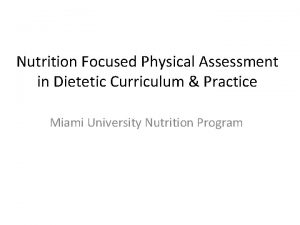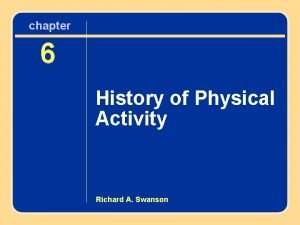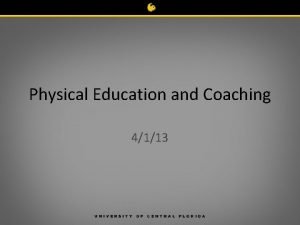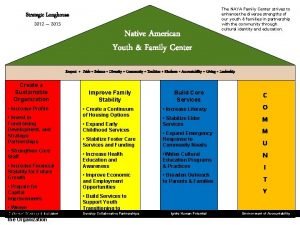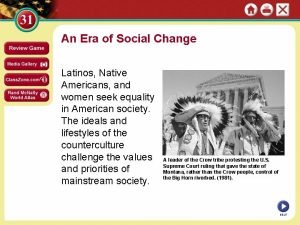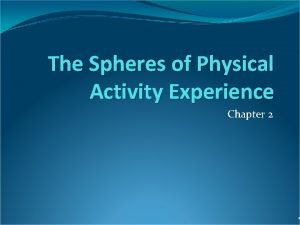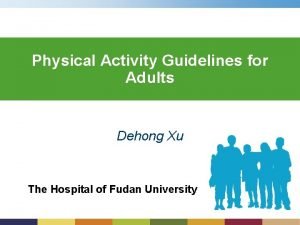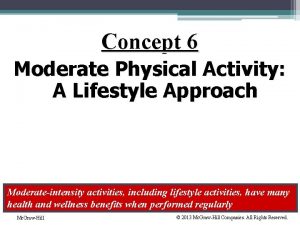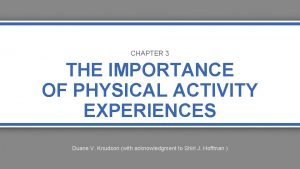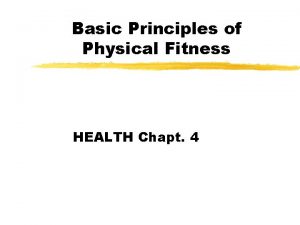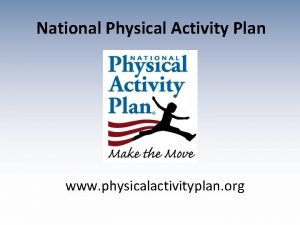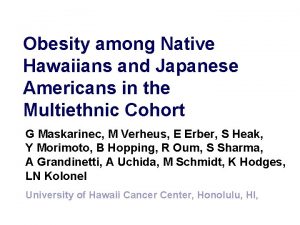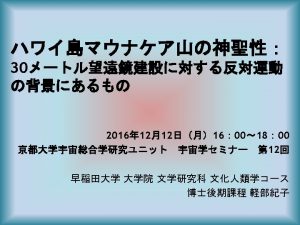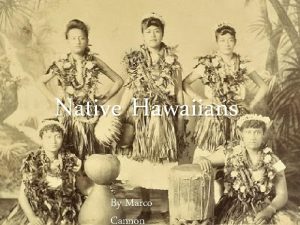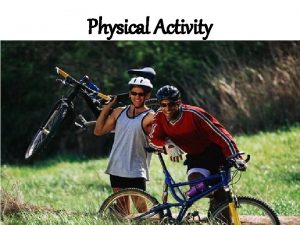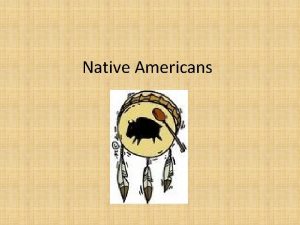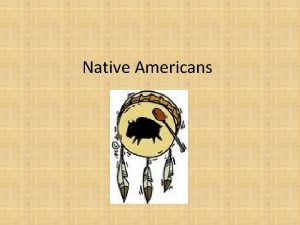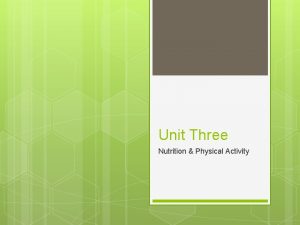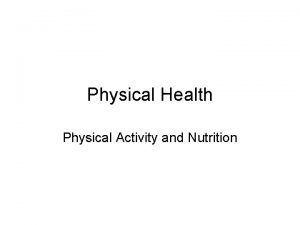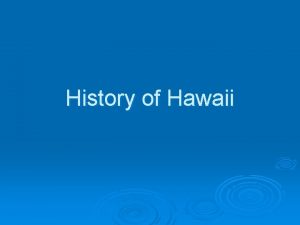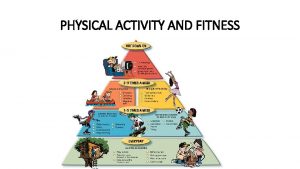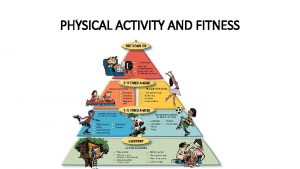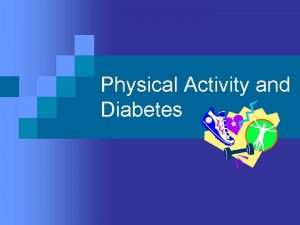Nutrition and Physical Activity in Native Hawaiians and





































- Slides: 37

Nutrition and Physical Activity in Native Hawaiians and Pacific Islanders A community and evidence-based perspective Archana J. Mc. Eligot CSUF Ka’ala Pang Kawai Pang Juliet Mc. Mullin UCR PIHP-Hawaii Charlene Kazner Ainahau O Kaleponi Hawaiian Civic Club

Objectives 1. Identify the community’s nutrition and PA challenges 2. Understand the health disparities for Pacific Islanders related to nutrition 3. Familiarize the audience to Pacific Islander dietary intakes and needs 4. Discuss the social determinants/cultural context for diet and PA in Pacific Islanders 5. Characterize dietary interventions in Pacific Islander populations

Our Values Pili Aloha Mālama kekahi I kekahi Maihila Na’auao Ano ano hua

Healthy Pacific Islanders Health problems aren’t necessarily “who” NHPI are, traditionally their diet, lifestyle and health conditions were excellent

Healthy Pacific Islanders Source: Brittany Todd

Healthy Pacific Islanders Discussion of weight, diet and exercise Weight as very unhealthy vs question of size Being able to do what you want to do. “I see some very big Hawaiians, but they’re still doing the things they want to do” “It’s the way you carry yourself” the emotion of being Hawaiian

Hula Warm-up

Pressing Problems Objective 2: Health Disparities related to nutrition and PA in NHPI

“Some of the problems are well known and we know what we should do…” Diseases Diabetes, heart disease, cancer Practices Diet and exercise Nutritious vs non-nutritious Fast vs home cooked Hawaiian vs American

What Are Our Health Disparities? - Population § According to the 2000 U. S. Census, there are 874, 000 reported Native Hawaiian and Other Pacific Islanders, which account for 0. 3% of the entire U. S. population 1. § Native Hawaiians and Pacific Islanders, as a group, experienced 2. 4% growth between 2007 and 2008, third overall among race groups; Asians and Hispanics were second and first respectively 2. § Native Hawaiians are the largest Pacific Islander group in the U. S. followed by Samoan, and Guamanian or Chamoru. These three groups account for 74% of the total respondents who reported belonging to a single Pacific Islander group 1. 1: Grieco, E. M. (n. d. ). The Native Hawaiian and Other Pacific Islander Population: 2000 (p. 1, Issue brief No. C 2 KBR/01 -14). doi: http: //www. census. gov/prod/2001 pubs/c 2 kbr 01 -14. pdf 2: Paisano, Edna L. We the American: Pacific Islanders. Rep. Washington, DC: U. S. Government Printing Office, 1993. W. U. S. Department of Commerce Bureau of the Census, Sept. 1993. (p. 3) <http: //www. census. gov/apsd/wepeople/we-4. pdf>. From: White House Initiative on Asian Americans and Pacific Islanders Fact Sheet

What Are Our Health Disparities? § Native Hawaiians are over 5 times as likely to experience diabetes between the ages of 19‐ 35 (11% vs. 2%) compared to non‐Hawaiians (Mau, Epi Reviews, 2009; Papa Ola Lokahi, NH Epi Center Pub). § Native Hawaiians have the highest rate of deaths due to cancer compared to any other ethnic group in Hawaii (229 per 100, 000) and the 2 nd highest rate in the country. (Chu KC, Cancer 2005).

What Are Our Health Disparities? § Pacific Islanders reported higher adjusted rates of hypertension (1. 50; 1. 06, 2. 13), diabetes (1. 82; 1. 25, 2. 63), asthma (2. 32; 1. 65, 3. 25), and arthritis (1. 68; 1. 20, 2. 35). Pacific Islanders also more frequently reported having fair or poor health (1. 46; 1. 05, 2. 04). § Most differences in self-reported health status and chronic disease outcomes were mediated by higher rates of overweight and obesity, but not higher rates of smoking, among Pacific Islanders (Bitton, J Gen Intern Med. 2010). § According to the CDC, Native Hawaiians and other Pacific Islanders have the second highest rate of diagnoses of HIV infection and the second shortest AIDS survival rate of all Americans (Stafford, AJPH, 2010).

Health in Children Source: Ethnic Health Assessment for Asian Americans, Native Hawaiians, and Pacific Islanders in California, August 2010 § Among children, California schools use Healthy Fitness Zones (HFZ) to evaluate whether a student meets the HFZ goal of physical activity and body composition. § NHPIs reported the highest proportion of 5 th graders whose Body Mass Index (BMI) are not in the HFZ, with Samoans (53. 9%) and Other Pacific Islanders (41. 5%) having the highest rates across all racial/ethnic groups. § Guamanian (34. 7%), Native Hawaiian (34. 6%), and Tahitian (34. 4%) Californians also reported higher rates of 5 th graders whose BMI are not in the HFZ compared to the state average (32%). § More Samoan, Guamanian, Native Hawaiian, and Tahitian children have a body mass index (BMI) not within the Healthy Fitness Zone compared to the state average.

Mc. Eligot, Mc. Mullin, Pang, HMJ, 2010 H ig h d ee e du at eg r D . . . ge le C ol G ra va nc e Ad ol le ge C e m So Eq ui e ok e al e ok Sm Sm e/ ra du at ol G nt y ur re ly re nt C ur ot C N Sc ho s oe Mean Age = 60 D Fe m e al M Demographics of DABS 100 90 80 70 60 % 50 40 30 20 10 0

What Are Our Health Disparities? Chronic Condition No 49% Mc. Eligot, Mc. Mullin, Pang, HMJ, 2010 Yes 51%

Cardiometabolic Disease No 25. 81 Yes 74. 19 Mc. Eligot, Mc. Mullin, Pang, HMJ, 2010

Body Mass Index 8% Normal 33% 58% Mc. Eligot, Mc. Mullin, Pang, HMJ, 2010 Overweight Obese

`A`ohe hana nui ke alu `ia (No work is too large when done by all) Objective 3. Familiarize the audience to Pacific Islander dietary intakes and needs Objective 4: Discuss the social determinants/cultural context for diet and PA for NHPI

What Are We Eating? Major studies on Diet and Nutrition for NHPI § Wai’anae Diet Program, incorporated traditional Hawaiian values with a Traditional Hawaiian Diet (THD) of kalo (taro), poi (mashed taro), ‘uala (sweet potato), fish and chicken (1 - 3). § The PILI ‘Ohana project, a CBPR partnership, conducted in Hawai`i encourages culturally-sensitive healthful lifestyle behavior change through various nutrition and physical activity strategies (4), and results have shown reduction in weight and dietary fat intakes. § The Multi-ethnic cohort study, cross-sectional study between Hawaii and California assessing dietary intakes among five ethnic groups 1. Fujita R, Braun KL, Hughes CK. The traditional Hawaiian diet: a review of the literature. Pac Health Dialog. 2004; 11: 250 -9. 2. Shintani T, Beckham S, O'Connor HK, Hughes C, Sato A. The Waianae Diet Program: a culturally sensitive, community-based obesity and clinical intervention program for the Native Hawaiian population. Hawaii Med J. 1994; 53: 136 -41. 3. Shintani T, Beckham S, O'Connor HK, Hughes C, Sato A. The Waianae Diet Program: a culturally sensitive, community-based obesity and clinical intervention program for the Native Hawaiian population. Hawaii Med J. 1994; 53: 136 -41. 4. Nacapoy AH, Kaholokula JK, West MR, Dillard AY, Leake A, Kekauoha BP, Palakiko DM, Siu A, Mosier SW, Marjorie KM; PILI 'Ohana Project. Partnerships to address obesity disparities in Hawai'i: the PILI 'Ohana Project. Hawaii Med J. 2008 Sep; 67(9): 237 -41.

What Are We Eating? Whole Grain (serv) Refined Grain (serv) Vegetables (serv) Fruits (serv) Fiber (g) Monounsaturated Fat (%) Polyunsaturated Fat (%) Saturated Fat (%) Mc. Eligot, Mc. Mullin, Pang, HMJ, 2010 Total Fat (%) Mean 1. 63 3. 73 Recommende d Daily Allowance 4. 5 2. 52 1. 66 16. 84 13. 11 5 5 25 - 30 7. 21 11. 07 34. 39 < 10% < 30%

Mean (SD) Food Intake Energy kcal % Energy from fat Fiber, g Vegetable, servings Fruit, servings Whole grain, servings Refined grain, servings Total Folate, mg Natural Folate, mg Synthetic Folate, mg Vitamin C, mg Vitamin E, IU Total carotenoids, mgc Calcium, mg Iron, mg Supplement Intake Folate, mg Vitamin C, mg Vitamin E, IU Carotenoids, mgc Calcium, mg Iron, mg Males (N=21) Range % above guidelin esa, b 1882 (710) 33. 7 (5. 9) 19. 5 (6. 3) 2. 9 (1. 7) 1. 9 (2. 1) 2. 0 (2. 0) 4. 0 (1. 5) 452 (204) 265 (125) 187 (166) 110 (92) 10. 3 (6. 2) 10913 (6676) 754 (459) 15. 5 (5. 5) 992 -3220 22. 3 -44. 2 7. 9 -30. 1 0. 7 -6. 6 0 -8. 3 0 -8. 6 0 -7. 3 240 -995 123 -609 46 -853 28 -322 3. 4 -28. 0 1672 -25118 234 -2433 8. 9 -32. 2 175 (246) 168 (404) 94 (214) 217 (598) 139 (272) 2. 4 (8. 2) 0 -900 0 -1500 0 -833 0 -2550 0 -1120 0 -36. 3 24 19 14 14 5 66 52 19 5 48 19 10 100 33 38 43 0 10 Mean(SD) Females (N=34) Range % above guidelinesa, b 1601 (615) 34. 8 (8. 4) 15. 2 (7. 3) 2. 3 (1. 4) 1. 5 (1. 2) 1. 4 (1. 3) 3. 5 (2. 1) 393 (285) 204 (89) 190 (236) 83 (53) 13. 4 (17. 4) 8857 (6568) 714 (332) 13. 6 (9. 6) 579 -3010 18. 2 -48. 3 2. 8 -31. 4 0 -5. 8 0 -5. 6 0 -5. 4 0 -9. 0. 104 -1781 123 -607 23 -1373 23 -205 1. 8 -100. 9 487 -25161 129 -1568 4. 4 -61. 2 251 (309) 163 (330) 65 (151) 1247 (6500) 367 (661) 3. 8 (8. 3) 0 -1000 0 -1060 0 -667 0 -38002 0 -2970 0 -36 22 12 3 3 0 56 35 3 9 44 18 9 79 44 26 47 9 18

Bitton A. J Gen Intern Med , 2010

Bitton A. J Gen Intern Med , 2010

“Hawaiians don’t eat until they’re full, they eat until they’re tired” - Joking and portion size It’s disrespectful not to eat what’s on your plate We bring lots of food to social events “that’s how you know who is Hawaiian” We expect to see lots of food at social events Similar across Pacific Islander groups Generational issues Depression era Poverty “It’s difficult to preach to family members…” Individual choice People are stubborn

D. A. B. S. Diet Attitudes and Beliefs Study Top 5 Choices Poi Fish Lomi lomi salmon Laulau Sweet Potato Others : rice, taro leaf, ulu

Objective 4: Social Determinants Migration issues Fund raisers for groups back home Access to food and changes in food Research by Craig Janes – Samoan Communities Migration, Social Change, and Health: A Samoan Community in Urban California. Stanford University Press 1990 Various political relationships Watch Talk Story with George and Greta Briand (Marshall Islands)

Objective 4: Social Determinants

Acculturation, Migration and Diet Source: Brittany Todd: http: //brittanytodd. hubpages. com/hub/Hawaiian-Food-Culture-The-Evolution-and-Effects-of-Local-Food#

Acculturation, Migration and Diet Source: Brittany Todd: http: //brittanytodd. hubpages. com/hub/Hawaiian-Food-Culture-The-Evolution-and-Effects-of-Local-Food#

Reasons for Leaving Country of Birth OPPORTUNITY Better Job American Dream Change of Life Experience Living Away from Home College

Stress, work and distance “It’s just more stressful to live in California” Longer work hours Activities after work Staying home to do homework, playing video games Commuting – “I just feel so lucky to be home” Local environment Beaches and parks are often very far away from where you live and work Safety of the environment

Stress, work and distance http: //www. youtube. com/watch? v=-awm. SB 2 L 7 UE Dateline – “The Wai’anae Diet” Interview on Hawaiian Obesity

“To help get our ‘ōkole going…” Social vs individual “if the kids go, then I have to go. And if the kids are there, then the grandparents will go” “Activities should be social events, but should have a component that shows us how to do these things at home. ” Photo from www. ferenc. biz/archives/storiesofphotographers

Access Environment and healthy spaces where you can get Hawaiian foods “I lived here 10 years before I finally was able to hook up with the community. Now I am learning where I can get Hawaiian foods. ” How to share foods Too much food for the kupuna or singles Community Gardens Famili Pe Taha – Steven Fifita

Objective 5: Characterize dietary interventions in NHPI populations – Traditional Hawaiian Diet (THD) Traditional Foods: • kalo (taro) • weet potato • poi (mashed taro) • fish • chicken • (both fish and chicken were occasionally eaten). Preparation and cooking methods. Traditional Hawaiian diets were extremely low in fat primarily due to the simplicity of the cooking methods, as well as consumption of a high fiber, complexcarbohydrate diet. Cooking methods emphasized for the present study include: • Baking • Steaming • Broiling • Boiling

Objective 5: Characterize dietary interventions in NHPI populations – PILI ‘Ohana The PILI ‘Ohana program includes eight sessions focusing on lifestyle change, including: 1) Overview of the PILI Lifestyle Intervention 2) Getting started on eating less fat 3) Being more active 4) Healthy eating and monitoring 5) Keeping to reduced calories 6) Taking charge of your diet/environment 7) Communicating with health care providers 8) A wrap up session Mau MK, Keawe'aimoku Kaholokula J, West MR, Leake A, Efird JT, Rose C, Palakiko DM, Yoshimura S, Kekauoha PB, Gomes H. Prog Community Health Partnersh. 2010 Spring; 4(1): 7 -16.

`A`ohe hana nui ke alu `ia v. Native Hawaiian Community v Ka’ala and Victor Pang & PIHP-Hawaii v. Momi Bone & Charlene Kazner Ainahau O Kaleponi Hawaiian Civic Club v. CSUF – Archana J. Mc. Eligot v. CSUF - Michele Wood v. WINCART – Sora Tanjasiri v. UCR – Juliet Mc. Mullin v. CSUF students v. Shauna Winston v. Rebekah Ngewa v. Ryan Alano v. Tiffany Price
 Physical activity and nutrition coordinator
Physical activity and nutrition coordinator Physical fitness test grade 9
Physical fitness test grade 9 Nutrition focused physical exam training
Nutrition focused physical exam training Palpation percussion auscultation
Palpation percussion auscultation Debye huckel equation
Debye huckel equation Who global strategy on diet, physical activity and health
Who global strategy on diet, physical activity and health Ocr level 3 sport
Ocr level 3 sport Between 1950 and 2000, physical activity professions
Between 1950 and 2000, physical activity professions Fitness chapter 12
Fitness chapter 12 Sport pedagogy definition
Sport pedagogy definition Safe and smart physical activity
Safe and smart physical activity Safe and smart physical activity
Safe and smart physical activity Chapter 3 benefits of physical activity
Chapter 3 benefits of physical activity Physical and chemical properties sorting activity
Physical and chemical properties sorting activity Negatives of commercialisation in sport
Negatives of commercialisation in sport Reactants, products, and leftovers
Reactants, products, and leftovers Aoa and aon difference
Aoa and aon difference Form content and use
Form content and use Activity 2 finding the sequence
Activity 2 finding the sequence 03 activity 1
03 activity 1 Activity 1 activity 2
Activity 1 activity 2 Non physical fences example
Non physical fences example Native american youth and family center
Native american youth and family center Native american morals and values
Native american morals and values Latinos and native americans seek equality
Latinos and native americans seek equality Sphere of physical activity
Sphere of physical activity Vigorous activity examples
Vigorous activity examples Moderate physical activity examples
Moderate physical activity examples Moderate physical activity
Moderate physical activity Way of life that involves little physical activity
Way of life that involves little physical activity Chapter 12 lesson 3 planning a personal activity program
Chapter 12 lesson 3 planning a personal activity program Professional experience in physical activity
Professional experience in physical activity Physical activity pyramid worksheet
Physical activity pyramid worksheet Chief medical officers physical activity guidelines
Chief medical officers physical activity guidelines Primitive physical activities
Primitive physical activities National physical activity plan
National physical activity plan Physical fitness definition
Physical fitness definition Sociology of physical activity focuses on
Sociology of physical activity focuses on


